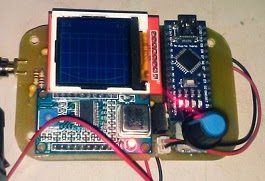This is really nice. DuWayne KQ4VB, has been talking to Pete about his use of digital chips, Arduinos and TFT displays in homebrew SWR analyzers. Obviously these techniques could be used to measure the passband of crystal filters. (Far superior to my pencil and paper procedures.) Nice work DuWayne!
Pete
Looks good, I did some playing with the TFT board I have. Did a board for the antenna analyzer using the TFT and a 9850 DDS module insted of the NOKIA and si5351. Wanted to see if there was much difference between a sine wave out and the square wave from the 5351. Appears to be very nearly the same from a couple of quick tests I have done. Want to try some different diodes and change some values for amplifier gain.
Will keep you informed. DuWayne
Earlier... (4 November 2014)
Pete
Really enjoy listening to you on Solder-Smoke. Saw the link to your
xcvr with the Adafruit si5351 board. I got a couple of them and have
been playing with code for them. Have been spending most of my time
working on an antenna analyzer based on the one by K6BEZ. Pleased to see
your article in the latest QQ. I have used basically the same circuit,
except am using the little NOKIA LCD display. The resolution is not the
greatest but works well for this application. I am using some of the
original code from K6BEZ to talk with his existing PC program. For
stand alone I have 2 modes, a straight tune mode where I can select the
frequency and read the SWR. Also implementing a sweep mode that scans
the whole band and after it is finished you can tune across and see the
frequency and SWR. I am attaching a couple of pictures of what I have
so far. Waiting on the correct op amp to arrive and making some changes
to the amp gain to get better results on the higher band where the
output of the DDS drops off.
Thanks for all the inspiration you give to us home builders and tinkerers
out here.
73 DuWayne KV4QB
Our book: "SolderSmoke -- Global Adventures in Wireless Electronics"
http://soldersmoke.com/book.htm
Our coffee mugs, T-Shirts, bumper stickers:
http://www.cafepress.com/SolderSmoke
Our Book Store:
http://astore.amazon.com/contracross-20































